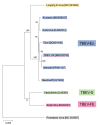Tick-Borne Encephalitis Virus, United Kingdom
- PMID: 31661056
- PMCID: PMC6924911
- DOI: 10.3201/eid2601.191085
Tick-Borne Encephalitis Virus, United Kingdom
Abstract
During February 2018-January 2019, we conducted large-scale surveillance for the presence and prevalence of tick-borne encephalitis virus (TBEV) and louping ill virus (LIV) in sentinel animals and ticks in the United Kingdom. Serum was collected from 1,309 deer culled across England and Scotland. Overall, 4% of samples were ELISA-positive for the TBEV serocomplex. A focus in the Thetford Forest area had the highest proportion (47.7%) of seropositive samples. Ticks collected from culled deer within seropositive regions were tested for viral RNA; 5 of 2,041 ticks tested positive by LIV/TBEV real-time reverse transcription PCR, all from within the Thetford Forest area. From 1 tick, we identified a full-length genomic sequence of TBEV. Thus, using deer as sentinels revealed a potential TBEV focus in the United Kingdom. This detection of TBEV genomic sequence in UK ticks has important public health implications, especially for undiagnosed encephalitis.
Keywords: Ixodes ricinus; TBEV; United Kingdom; deer; flavivirus; immunological surveillance; louping ill virus; meningitis/encephalitis; sentinel animals; tick-borne encephalitis; tick-borne encephalitis virus; tickborne infections; ticks; vector-borne infections; viruses; zoonoses.
Figures


Comment in
-
Detection of tick-borne encephalitis virus in the UK.Lancet. 2020 Feb 8;395(10222):411. doi: 10.1016/S0140-6736(20)30040-4. Lancet. 2020. PMID: 32035545 No abstract available.
References
-
- Animal & Plant Health Agency; Scotland’s Rural College. GB sheep disease surveillance dashboard [cited 2019 May 20]. https://public.tableau.com/profile/siu.apha#!/vizhome/SheepDashboard_/Ov...
-
- Animal & Plant Health Agency; Scotland’s Rural College. GB cattle disease surveillance dashboard [cited 2019 May 20]. https://public.tableau.com/profile/siu.apha#!/vizhome/CattleDashboard/Ov...
Publication types
MeSH terms
Substances
LinkOut - more resources
Full Text Sources
Molecular Biology Databases

